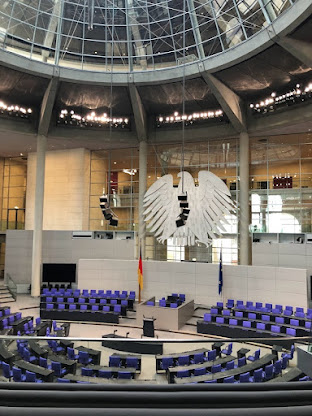Blocker Blog – Entry 1: An Introduction to the (City/Museum) Scene
With the S-Bahn heading towards the center of the German capital on a windy Wednesday morning, I notice a relative emptiness on the streets and on metro stations. This is not like any other large city, especially during rush hour, at least this was my first impression after an overnight flight from Mexico City . Though it still feels like I am in a US city, what throws me off would be the moment that people speak, or when a station is announced, with umlauts and ß’s being thrown (I am personally more familiar with tl-, -ec, xo- and tz- sounds for many names of roads and places are Nahuatl names in central Mexico).
Despite these
differences and similarities, I have gotten so far, a first glimpse of the variety
of museums and exhibitions that Berlin has to offer. When first hearing about
Berlin having an entire island of museums and historical sites, I was left with
curiosity as to how it looks in person, to which I can say that it is very well
integrated with the rest of the city. A particular Museum that I have been
interested in visiting and studying is the Humboldt Forum. Being one of the museums
on Museum Island, it is in the center, across the street from the Altes Museum
and perpendicular to the Berlin Cathedral. The Forum has two types of façades
that are neoclassical and contemporary respectively. Like many other parts of
Berlin currently, there are some parts of the building that are currently under
construction, while there also being coverings of statues due to the seasonal
weather conditions. I am to focus in this particular institution because its
multifaceted historical weight that has brought many conversations regarding
the ownership of looted items during Germany and Europe’s colonial past. I see
Berlin of all cities region that has taken the time to remember its history,
both current and distant, in a diverse set of ways. On my second day in the
city, our program’s tour guide told us a word that encapsulates this action of
recognition: Vergangenheitsbewältigung. A vague translation of this
would be ‘an attempt to learn to live with the past’; I was thinking of this
term as the tour continued and we saw multiple memorials to the victims of the
Holocaust as well as monuments for the destruction of cultural artifacts and buildings
during the Nazi regime. This effort to learning to live with the past is
something that I hope to continue seeing during my stay.
During all of these trips that I have had throughout Berlin, it has made me think about the relationship that historical and ethnological museums have with their collections. As having a strong social foundation in Mexico, I can confidently say that the such relationship between museums and their collections is much different, generally-speaking. For Mexico, historical and cultural artifacts of the nation are valued and deservedly well treasured, with there being relatively open and accessible efforts to educate the public of their history and significance to a particular community within the country, which in the case of Mexico it can be any of its over 60 indigenous communities. In the case for Berlin, there seems to be a need to recognize the tempestuous history of these objects, to which are physically far away from the people who made them and put cultural worth into them. Overall, this I think will be a very extensive journey to discover at the Humboldt Forum and similar institutions. Though the term Vergangenheitsbewältigung is a term used in the context of remembering the horrors of the Holocaust, I am vigilant in extending that context further back to horrors that are were not filmed, nor they are in recent memory but are very much felt, as I continue to learn from this city.






Comments
Post a Comment